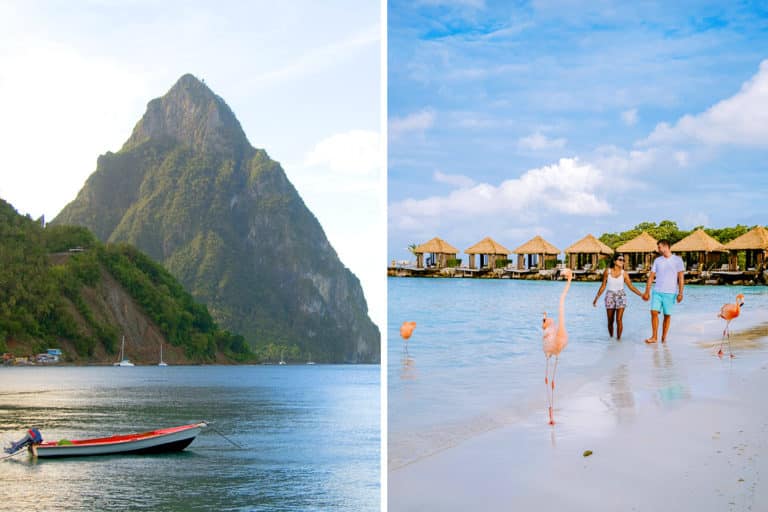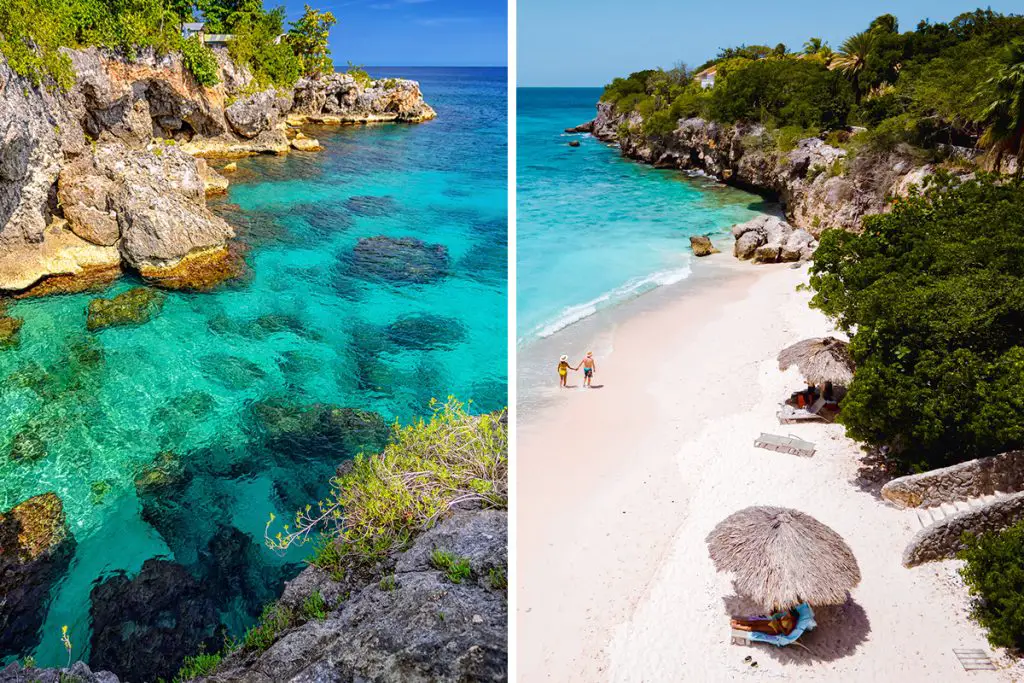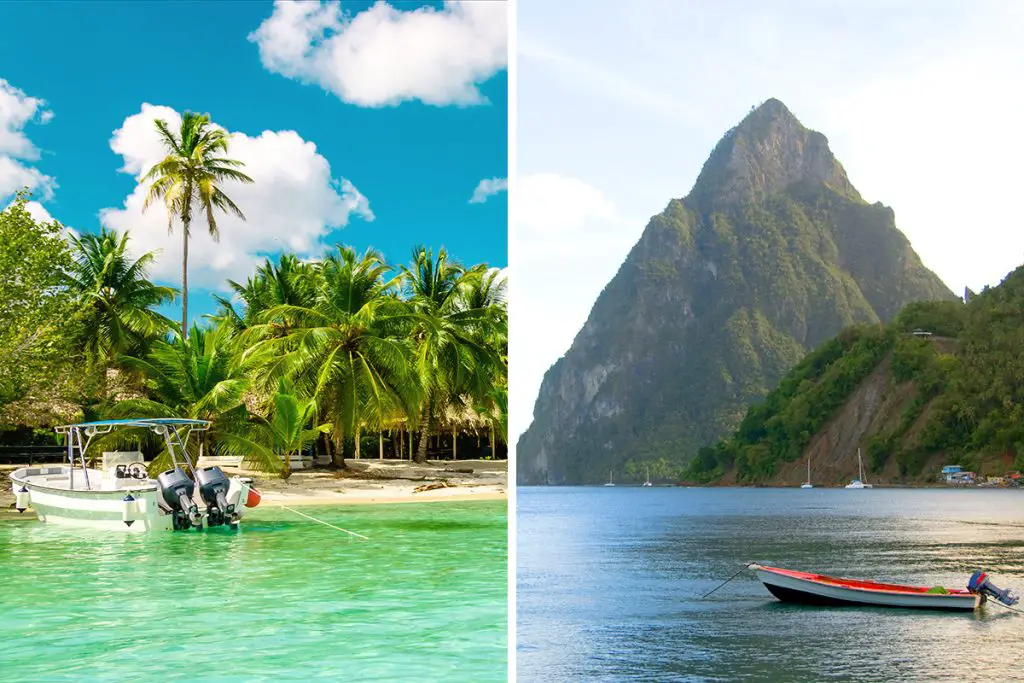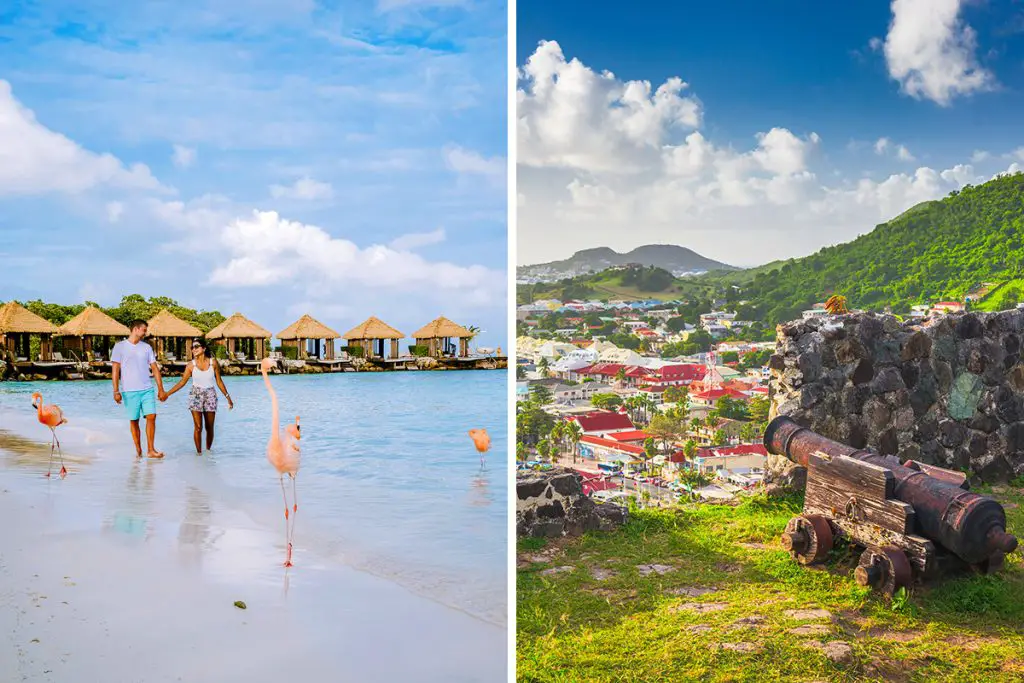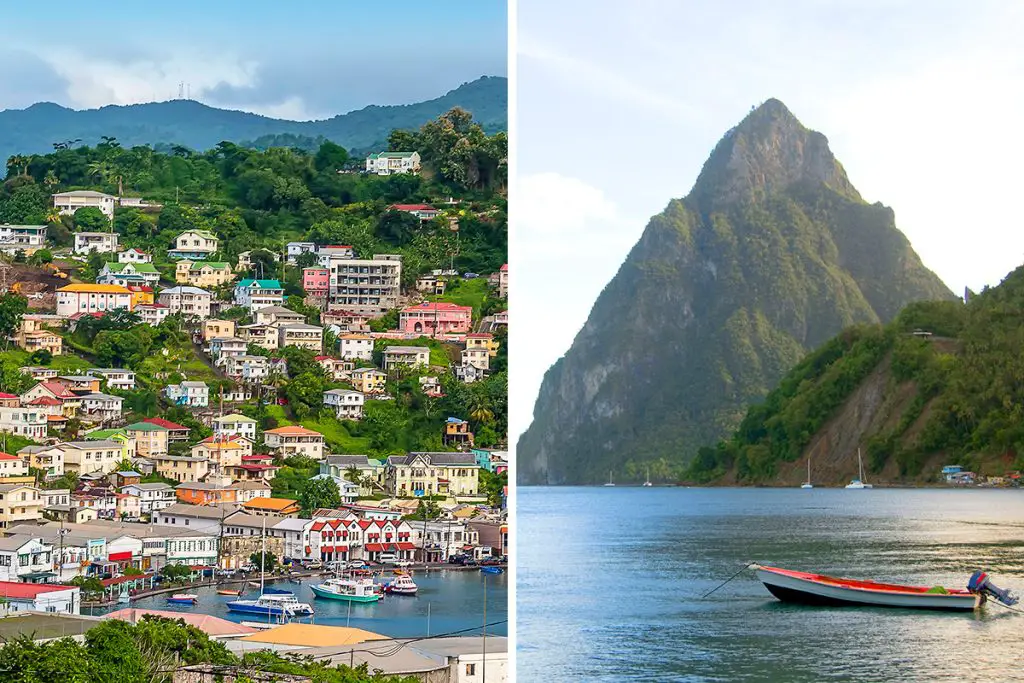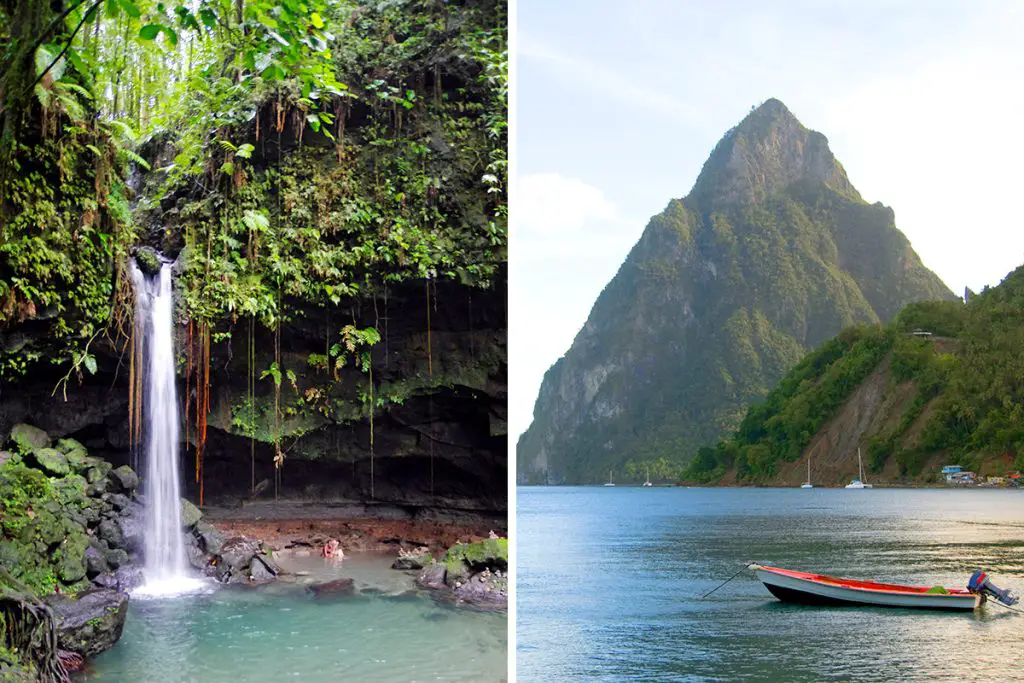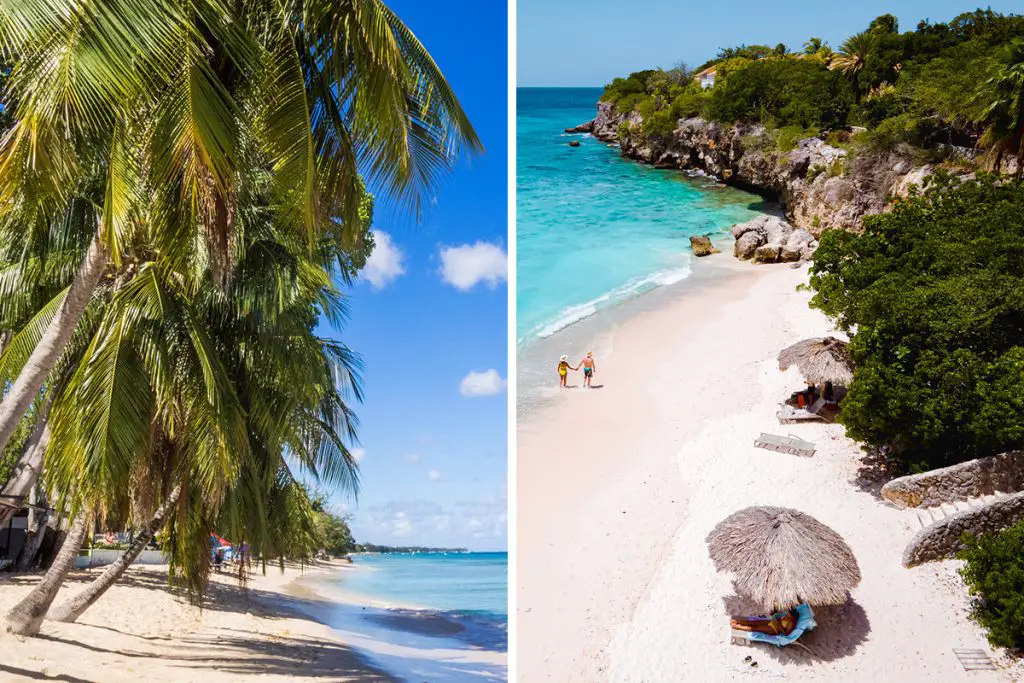St. Lucia is ranked as one of the most beautiful islands in the Caribbean region. It is particularly known for its majestic coastline and grandiose landscapes. Tourism on the island greatly encourages exploration and adventures.
Aruba is another popular destination in the Caribbean. It is one of the most visited islands in the region, luring tourists with its pristine beaches and romantic atmosphere.
Both St. Lucia and Aruba are sure to provide an amazing vacation experience. However, how do you exactly decide which one to go for?
St. Lucia
St. Lucia is a small island located in the Caribbean’s Lesser Antilles region. Some of its neighboring islands include Martinique, Barbados, as well as St. Vincent and the Grenadines. Because of its picture-perfect beauty, St. Lucia is considered one of the most beautiful vacation spots in the Caribbean. It boasts its pristine coastlines and towering mountain peaks.
Although nothing compared to the larger islands such as Jamaica and Puerto Rico, St. Lucia’s small size provides easier travel. Tourists can explore different destinations in the islands relatively close to each other. Aside from that, there aren’t as many people to crowd popular attractions.
What Makes St. Lucia Unique?
Exploring the Towering Pitons
Sitting along St. Lucia’s southeastern coast is the monumental Piton Mountains. Nearly identical in structure, the Pitons are volcanic spires towering over the city of Soufriere. Both mountains stand over 700 meters high (2,296 ft) and are some of the most photographed landscapes on the island.
St. Lucia’s Piton Mountains consist of the Gros Piton and the Petit Piton. The Gros Piton is located in Soufriere and stands at 798.25 m (2,618.9 ft) high. Petit Piton’s base is closest to the town of Choiseul and is 743 m (2,438 ft) high. Both mountains are connected by the Piton Mitan ridge.
The most photographed angle of the Piton Mountains comes from the nearby stretch of Soufriere Bay.
Aside from its striking beauty, the Piton Mountains are also a popular hiking location. Gros Piton features several hiking trails tourists can follow to reach its peaks. Although challenging, these trails are well-marked, allowing even novice hikers to take on the towering Gros Piton.
On the other hand, the slightly smaller but steeper Petit Piton is not for amateur climbers. Petit Piton is considered a dangerous mountain because of its rugged terrain and steep elevation. Local officials only allow experienced and expert climbers to take on the mountain. But, those who want to climb Petit Piton need to secure a special permit first. Aside from that, St. Lucia also requires those climbing Petit Piton to include a local guide in their ascent.
Those who successfully climbed the Pitons are rewarded with amazing views of the island of St. Lucia. At the top, tourists have unobstructed views of the nearby Soufriere, Choiseul, and the surrounding coasts.
Tourist Center of Soufriere
Soufriere is a French town located in the valley between the Gros and Petit Pitons. Given its proximity to the twin mountains, the quaint town is one of St. Lucia’s primary tourist hubs. But aside from its location, the charming city itself is home to several tourist attractions.
Diamond Falls Botanical Gardens
The Diamond Falls Botanical Gardens in Soufriere is an internationally recognized and multi-awarded tourist attraction. Known as the oldest botanical garden in St. Lucia, Diamond Falls covers roughly 6 acres (2.4 ha) within the Soufriere Estate.
It features several garden exhibits and tailored landscapes. It is considered one of the most beautiful spots on the island because of its relaxing ambiance. The tourist site also draws tourists with the majestic Diamond Falls. The 50-feet-high (15 m) waterfall somehow changes colors depending on the direction of the sun. The striking blue pool at the bottom is also a beautiful sight to see.
Sulphur Springs Park
The Sulphur Springs Park is arguably the most visited tourist attraction in Soufriere and the rest of St. Lucia. The geothermal park is set on the Soufriere volcano and encompasses a total area of 114 acres (46 ha).
Recognized as the only drive-in volcano in the Caribbean, Sulphur Spring Park lies within one of the most active geothermal fields in the region. It is world-renowned for its hot springs and mud baths.
Visitors enjoy long baths in the park’s mud pools because of their deemed health benefits. Mud baths are believed to heal and detoxify the body, especially those dealing with joint pain and sunburns. The park also features the 50-foot-tall (15 m) Toraille Waterfalls.
Aside from the mud baths and hot springs, the site also includes guided tours talking about the Soufriere volcano’s history.
Tet Paul Nature Trail
The Tet Paul Natura Trail is one of St. Lucia’s most popular hikes. It is a relatively short trail that takes roughly 25 to 30 minutes to reach the final lookout. It runs through the Piton Mitan Ridge and provides scenic views of the Piton Mountains. The 1 km long (0.6 mi) trail can be an alternative for tourists who don’t feel like doing either of the Pitons.
Picturesque Coastline
St. Lucia’s beauty is more than majestic peaks. The Caribbean island also boasts several world-class beaches and coasts. Whether it be highly developed beach resorts, rugged surf beaches, or amazing coral reef systems, St. Lucia has it all.
Rodney Bay
Stretching along St. Lucia’s northern coast, Rodney Bay is one of the island’s most beautiful beaches. It was developed as a designated tourist hub with palm-lined beaches and local shops.
Rodney bay features a 10-km (6.2 mi) horseshoe-shaped beach and a man-made marina. This particular coastline is known for its lively atmosphere. A variety of tourist activities are available in the area including kitesurfing, diving, and snorkeling.
Rodney Bay is an upscale beach spot for tourists looking for a more premium vacation experience. There are numerous high-class resorts, upmarket restaurants, nightclubs, and cocktail bars along the beach.
Anse Chastanet Marine National Park
The Anse Chastanet Marine National Park is a designated protected reserve for St. Lucia’s coral reef system. It is a popular snorkeling and diving spot along the island’s west coast.
Found right between the Pitons, the beach offers an accessible beach for tourists. Some of the reef systems are only a few meters away from the coast. It is also accessible and viewable even in relatively shallow waters.
Marigot Bay
When it comes to scenic and picturesque coasts, it is impossible not to include St. Lucia’s Marigot Bay. Located along St. Lucia’s western coast, the Marigot Bay is widely considered to be the most beautiful shore on the island. The bay is also tucked between lush hills that add to its wondrous beauty.
Marigot Bay’s charm does not focus on the beach itself. Although tourists can still swim and enjoy a variety of activities such as kayaking. Several luxury accommodations and restaurants are found around Marigot Bay because of its exceptional landscape.
Historical Adventures at St. Lucia
St. Lucia also has a long and colorful history. Its tourism is also rich in sites related to the island’s history and cultural heritage. Before it became the tourist hub that it is today, St. Lucia shares its fair share of war and conflict.
The island’s story goes as far back to early settlers such as the Arawaks in 200 AD and the Carib Indians in 800 AD. St. Lucia also features traces of its history with piracy and colonialism in the Caribbean region. Historic buildings and ruins serve as reminders of the time the French, English, and Dutch forces tried to colonize the island.
Pigeon Island National Park
The Pigeon Island National Park is located right by the tip of St. Lucia’s northwestern coast. Sitting right next to the famous Rodney Bay, Pigeon Island is another popular tourist attraction in the region.
Pigeon Island was once an isolated island off the coast of St. Lucia. However, an artificial causeway was added to make access to the island easier for visitors. Covering a total of 18 ha (44 acres), the island features vast land for exploration.
Pigeon Island is known to be the site where the Arawak and Carib Indians first settled on St. Lucia. By the 16th century, a renowned French pirate, Jambe De Bois, occupied the island because of its strategic location.
The Pigeon Island National Park features several hiking trails. The trail is meant to take tourists up the island’s two peaks. However, it also takes visitors through a series of military ruins left on the island. It also includes some information about the site and the history of Pigeon Island.
On top of the island’s Signal Hill is the historic Fort Rodney. A British naval officer built the fort to serve as a lookout site. The higher vantage point provided a clear view over the island’s northwestern coast. Fort Rodney is well-preserved compared to other military buildings on Pigeon Island.
Morne Coubaril Historical Adventure Park
Morne Coubaril Historical Adventure Park is another underappreciated tourist destination in Soufriere. The park offers historical tours as well as an array of exciting activities. Located within an 18th-century estate, the historical park introduces St. Lucia’s plantation history.
The estate tour traces the history of the historic plantation the park is located at. It includes a guided trail through a small village built to replicate local life and activities centuries ago. The tour includes the grandiose mansion of the Monplaisir known for its Parisian design.
It also includes an interactive and immersive demonstration of the plantation process. Locals of St. Lucia will show how they work on cocoa beans and sugar cane to produce quality products.
Aruba
Aruba is a crown jewel located in the southern region of the Caribbean. Relatively isolated, this part of the Caribbean features the ABC islands. This group consists of Aruba, Bonaire, and Curacao. It has a total area of 180 sq. km (69 sq. miles) and is home to a little over 100,000 people.
Aruba is primarily known for its scenic beauty accompanied by the perfect tropical climate. It features a series of palm-lined beaches with pearl-white sand and calm waters. Much of its coast is developed as a tourist hub and numerous hotels and resorts line its beachfront.
Unlike other islands in the Caribbean, Aruba’s landscape is relatively flat. Although there are no grandiose mountains and towering peaks, the island is still rich in natural beauty. It features limestone cliffs, lush rolling hills, and a unique arid desert.
What Makes Aruba Unique?
Best Shipwrecks in the Caribbean
Snorkeling and diving are popular activities in the Caribbean. However, Aruba is particularly known for its amazing shipwreck diving sites. The average number of wreck spots in the Caribbean is only two. But Aruba features over ten well intact ships and airplane wrecks under the sea.
There are several popular dive spots surrounding the island of Aruba. Depending on the location, some wrecks are suitable for beginners while others are designated for experienced divers. These wrecks, some dating as far back as World War II, were torpedoed, stormed, or deliberately sunk off of Aruba’s coast.
SS Antilla
The SS Antilla is the most popular dive site in Aruba. Located a couple of hundred meters off of Arashi Beach, the SS Antilla is one of the island’s most popular tourist attractions. At 400 feet (122 meters) long, the SS Antilla is the largest wreck in Aruba and the Caribbean region.
SS Antilla was a German freighter commissioned in the early 19th century. During one of its voyages through the Caribbean, Dutch military forces tried to board the ship. To avoid captivity, the captain of the freighter purposely set the ship on fire before abandoning it.
The scuttled SS Antilla lies at only 66 feet (20 meters) deep. The shipwreck broke into two parts through time. It is a beginner-friendly dive spot since the surrounding water is generally calm and gentle. Given that the wreck is not too deep, visibility is also good. This allows even snorkelers to view that ship and its glory even at surface level.
Star Gerren
The Star Gerren wreck is a more advanced dive spot off of Aruba’s northern coast. Although not as popular as SS Antilla, the Star Gerren offers just about the same experience.
Dubbed as the Cinderella of the Aruban shipwrecks, the Star Gerren was a 73-meter-long (245 ft) German cargo ship. It experienced an unrepairable engine failure and was later on salvaged and abandoned. Because of its deplorable state, the Star Gerren was purposely sunk to serve as a dive spot in 2000.
The shipwreck sits a couple of kilometers off of Hadicuraru Beach and sits roughly 70 feet (21 meters) underwater. Since it is slightly deeper, this dive site is more suited for experienced open-sea divers.
Debbie II
The Debbie II is another shipwreck located off the northern coast of Aruba. It is a 120-foot-long (36 m) fuel barge that was deliberately sunk to serve as an artificial reef and an underwater attraction. It lies at a depth of 70 feet (21 meters) and is home to a variety of marine life.
This wreck is significantly smaller than the neighboring SS Antilla and Star Gerren. But, the Debbie II wreck is still a sight to see. Also, diving tours to the Debbie II are often accompanied by a trip to the nearby Blue Reef.
Jane Sea
The Jane Sea wreck is one of the most popular dive spots in Aruba. The 170-foot-long (51 m) ship was an English freighter used to transport cement. However, local lore says that the ship was later used by drug smugglers to transport cocaine. Thus, earning the moniker, Jane C.
The story of Jane Sea’s demise has two versions. One says that the ship was confiscated by authorities because of the cocaine scandal. Others say that the crew abandoned the ship when the owner failed to pay their salaries. Regardless, the Jane Sea was left anchored in Barcedera Harbor for long before local dive operators pushed to use the ship as an artificial reef.
The ship was finally sunk in 1988 near the Barcadera Reef roughly 100 feet (30 meters) under. The Jane Sea is an advanced diving spot given that the ship sits relatively deeper. Aside from that, the underwater current is also notably stronger around this part of Aruba.
Pedernales
The Pedernales wreck was a lake tanker dating back to the Second World War. In 1942, the ship was torpedoed by German forces. Although the ship survived the attack, it was heavily damaged and considered undeployable. Dutch military forces used the damaged Padernales ship as a target for their gunners before it finally sank.
The wreck sits under relatively shallow waters under 25 feet (7 meters). The site features what remains of the Pedernales ship after taking in so much damage. It is of Aruba’s shipwreck dive spots suited for beginners.
Kappel
The Kappel is Aruba’s latest addition to its collection of shipwrecks. Located right off the secluded beach of Mangel Halto, the Kappel wreck is an added tourist attraction on Aruba’s western coast.
Sitting 45 feet (13 meters) underwater, the Kappel wreck features a small tugboat. The wreck was quickly covered in colorful corals in a span of three years. With the addition of the Kappel wreck in 2009, the coast of Mangel Halto became one of the best snorkeling and diving spots in Aruba.
The Cultural Center of Oranjestad
Oranjestad serves as the capital city of the island nation of Aruba. It lies along the island’s southern coast, it is the largest and most populated city in Aruba. It features the port of Oranjestad which serves as the primary commercial harbor. Many of the cruise ships visiting Aruba enters through the port at the edge of the city.
The development of Oranjestad quickly picked up as the island’s tourism flourished. Known for its colorful architecture, Oranjestad became one of Aruba’s main tourist hubs. It features several shopping stores, hotels, and activities for tourists to enjoy upon landing.
Wilhelmina Park
Wilhelmina Park is considered one of the most important places in Aruba historically and culturally. The site served as the city’s main square for centuries. It is witness to the city’s history and growth throughout the years.
Located at the center of the park is a statue of one of Aruba’s most prominent figures, Queen Wilhelmina. She was a Dutch leader that reigned over the island for 50 years, including years during World War II.
The park is well decorated and maintained. Numerous trees provide shade and a calming breeze. Given its location, Wilhelmina Park also has amazing views of the vast ocean on one side.
Fort Zoutman
Known as the oldest building in Aruba, the historic Fort Zoutman is one of the most popular tourist attractions in Oranjestad. Built sometime in the late 1700s by African Slaves, Fort Zoutman is a military fortress used by the Dutch military. It served as a stronghold for the Dutch against other colonizers and pirates.
Given its history, the fortress was designated by UNESCO as a ‘Place of Memory of the Slave Trade Route in the Latin Caribbean’.
The site houses the Fort Zoutman Historical Museum. Its expansive galleries and exhibits introduce visitors to Aruba’s history. Fort Zoutman also hosts a weekly event known as the Boon Bini Festival. It serves as a welcoming party that aims to celebrate the island’s rich culture and long history.
Exploring the Arikok National Park
Aruba’s geography is not as diverse or grandiose as other Caribbean islands. Aside from the lone 165-meter-high (541 ft) Hooiberg mountain, the rest of the island is relatively flat. Although some may think that this is disappointing, Aruba features many hidden gems.
The Arikok National Park was established in 2000 and is one of the island’s most popular attractions. With a total of 34 sq km (13 sq mi), the park covers roughly 20% of the island of Aruba. The park stretches through Aruba’s southeastern region near Oranjestad and Sta. Cruz.
The national park features some of the island’s most unique landscapes and geographic formations. This includes lava formations, limestone formations, and quartz diorite formations. In contrast to the Caribbean’s tropical feel, the Arikok National Park has an arid and desert-like environment.
Aside from its landscapes, the area covered by the Arikok National Park also holds some historical and cultural significance. The cave system in the park features several Pre-Columbian and early European cave drawings.
Natural Bridge of Anicouri
The Natural Bridge of Anicouri is arguably one of the most scenic and unique geographic formations on the island. The natural coral rock bridge was formed through years of continuous erosion.
The degradation resulted in a 100-foot-long (30 m) bridge 25 feet (7.5 m) above the sea. Although the natural arch collapsed in 2005 due to Hurricane Katrina, its ruins are still visited by tourists.
Boca Prins
Boca Prins is one of Arikok’s and Aruba’s most popular attractions. Located along the island’s northeastern coast, Boca Prins is a secluded beach famous for its massive dunes. It also features massive limestone cliffs hugging the bay. The contrast between the delicate white sand and rugged limestone cliffs makes Boca Prins one of the most iconic sceneries in Aruba.
Although Boca Prins draws tons of tourists, the beach itself is not suitable for swimming. There are several posts and warnings around the area reminding visitors not to enter the sea because of harsh waves and strong undertows. However, 4×4 drive activities are extremely popular around the desert-like coast.
Dos Playa
Dos Playa is Arikok National Park’s more commercial-friendly beach. Situated slightly north of Boca Prins, Dos Playa features a pristine white-sand coast with several limestone formations. The beach is a lot calmer around this part which makes Dos Playa a suitable place for water activities. Aside from its unique scenic landscape, Dos Playa is also famous for surfing and bodyboarding.
Jamanota Hilltop
Jamanota Hilltop is one of the few peaks found on the island of Aruba. With an elevation of 180 m (590 ft), Jamanota Hilltop provides amazing views of central Aruba as well its eastern coast. Visitors heading up to Jamanota Hilltop can drive up the trail but it requires a powerful 4×4 vehicle to do so.
Aruba’s Cultural Heritage
Aruba is considered a melting pot of different cultures. Starting from the Caiquetio Indians to the Spanish and Dutch colonizers, Aruba’s cultural heritage reflects much of these influences. Even as the island developed, many tourist attractions aim to celebrate Aruba’s rich culture and long history.
Aruba Aloe Factory and Museum
The Aruba Aloe Factory and Museum is one of the best places for tourists to know more about Aruba’s history. Located in Hato, the aloe factory and museum is set in one of the biggest plantations on the island. Going back 160 years ago, the 150-acre (60 ha) aloe farm features a guided tour that discusses Aruba’s hundred-year-old history in the aloe industry.
Bushiribana Gold Mill Ruins
Located along Aruba’s northern coast, the Bushiribana Gold Mill Ruins was one of the few gold mills built during Aruba’s gold history. Established in 1825, the site used the strong winds by the coast to help crush stones to pick out gold ores. The historic mill operated for more than a decade. However, it was completely shut down in 1899 when the gold industry of Aruba died.
Although only the ruins of the once-thriving Bushiribana Gold Mill remain, the site is still a popular attraction during ATV tours along the island’s northern coast. Certain structures of the building still stand and certain parts can be explored.
Philip’s Animal Garden
The Philip’s Animal Garden was founded in 2009 by a prominent Aruban native. It’s a nonprofit organization that houses a variety of animals including barn animals, crocodiles, and more. However, it is primarily known for its collection of exotic birds. It consists of more than 50 different bird species from various parts of the Caribbean.
Is Aruba or St. Lucia Better?
St. Lucia and Aruba are different than mainstream tourist destinations in the Caribbean. Compared to the likes of Puerto Rico or Jamaica, these smaller islands draw significantly fewer visitors. However, this proves to be an advantage as they can provide a more laid-back experience. Tourists can explore different destinations without having to deal with heavy crowds and long lines.
The Caribbean region is primarily known for its numerous tropical islands. St. Lucia and Aruba are exactly that. They feature amazing beaches, lush forests, and perfect summer weather all year round.
The island of St. Lucia is particularly known for its scenic landscapes. Thus, much of its tourism relies on its natural beauty. It features the towering Pitons, the majestic Reduit beach, and the historic Pigeon Island. Tourist attractions in St. Lucia provide visitors with the full Caribbean experience — amazing beaches, amazing hiking trails, and rich cultural heritage.
Aruba is known for two things – perfect beaches and shipwreck diving. Get the chance to lounge by the most beautiful beaches in the region or take your adventures under the sea. Either way, Aruba will never disappoint.
For tourists looking for an all-around vacation experience, the island of St. Lucia offers everything. You can get the chance to hike up mountains, swim through coral reefs, and explore historic sites. But if you are one to stick by the beach during vacations, Aruba is the perfect Caribbean island for you.
FAQs
Aruba vs. St. Lucia for Couples
The Caribbean region is a popular destination for couples. Because of its natural and scenic beauty, tourists love its romantic and intimate atmosphere. St. Lucia has its grandiose mountains while Aruba is known for its pristine and soft white sand. The beauty that St. Lucia and Aruba hold will not disappoint any couple planning a trip to either island.
However, there may still be some striking differences between St. Lucia and Aruba that couples may prefer over the other.
St. Lucia is primarily known for its exceptional natural beauty. It features majestic mountains, lush foliage, and beautiful beaches. There are several areas on the island developed to cater to the growing tourism industry of St. Lucia.
Marigot Bay is one of St. Lucia’s tourist centers. Several luxury and high-class accommodations are located around the bay because of its location. The scenic landscape of the bay and the surrounding hills significantly add to the romantic ambiance of the area. There are also upscale restaurants, shops, and stores along the bay’s coast.
However, many say that the beach along Marigot bay is not the best. The palm-lined beach is majestic, but the area is a lot smaller compared to other beaches. This makes the beach seem crowded and tight.
St. Lucia’s Rodney Bay is another designated tourist hub. The vast stretch of white sand provides ample space for visitors to enjoy the beach without dealing with too much crowd. Several beachfront resorts and hotels line Rodney Bay. Although these may seem like it is catered more to families, couples can still book a luxury room in one of these hotels.
Aruba’s charm emphasizes its collection of amazing white-sand beaches. Tourists can find a suitable coast to swim, surf, snorkel, or dive wherever they are on the island.
The Arashi Beach along the island’s northeastern coast is known for its handful of shipwreck diving spots. Along the east coast, Eagle Beach is considered the most beautiful stretch of white sand in Aruba. Lastly, the Baby Beach down south features calm turquoise water perfect for a quick and relaxing swim.
It all boils down to preference on whether St. Lucia or Aruba is a better destination for couples. However, it is safe to say that activities in Aruba focus mostly on the water, whether it’s swimming or wreck diving. On the other hand, St. Lucia’s picturesque beauty lure people to the island. Popular tourist attractions also involve a lot of hiking up the island’s towering peaks to better appreciate its scenic views.
St. Lucia or Aruba for Honeymoon
St. Lucia is one of the most popular honeymoon destinations in the Caribbean because of its natural beauty. It offers an intimate and romantic ambiance for couples staying on the island. But aside from its breathtaking views, there are numerous luxurious hotels in St. Lucia perfect for newlyweds.
St. Lucia offers an array of accommodation options for couples to choose from. There are several adult-only resorts in St. Lucia. Allowing people to enjoy their time in a more intimate and private setting. All-inclusive accommodations are also popular around St. Lucia. Couples can enjoy an expansive selection of amenities for the best honeymoon experience.
In terms of price, affordable accommodations for couples in St. Lucia can cost somewhere around $250 to $300. More luxurious and upscale resorts however cost well over $500 to over $1,000 per night. Prices of rooms and accommodation often depend on the location. This is because the view and environment play a huge role in the ambiance and overall experience of the couple.
Aruba is also a popular honeymoon spot because of its year-round tropical climate. Since the island of Aruba lies outside of the Caribbean’s hurricane belt, couples can fly in and find a summer paradise.
Aruba has several hotels and resorts throughout the whole island. Therefore, couples wouldn’t have any problem finding a suitable place for their honeymoon. Aruba has everything from private villas, to megaresorts, and luxury hotels.
Whether it be north, east, west, or south part of the island, newlywed couples will sure get to enjoy Aruba’s world-class beaches. Some of the most popular spots in Aruba include Arashi Beach up north, Baby Beach down south, and the amazing Eagle Beach along the west coast.
The average price for a honeymoon package in Aruba is around $5,000 to $8,000 but this already includes airfare. On a per night basis, rooms can be priced from $250 to $400 while rooms at popular all-inclusive resorts in Aruba range from $400 to $750.
Where Is St. Lucia Compared to Aruba?
The estimated distance between Aruba and St. Lucia is 986 kilometers (613 miles). The vast Caribbean Sea separates the two islands.
St. Lucia is located in the eastern end of the Caribbean region while Aruba is located along the southern part. The island of St. Lucia belongs to the collection of small islands known as the Lesser Antilles. Its neighboring countries include Barbados, Martinique, as well as St. Vincent and the Grenadines.
Aruba belongs to a rather isolated group of islands in the southern end of the Caribbean. Along with Bonaire and Curacao, Aruba completes the region’s renowned ABC islands. It is located right off the northern coast of Venezuela.
How Far Is St. Lucia From Aruba?
St. Lucia and Aruba are located in two different parts of the Caribbean region. St. Lucia lies within the Lesser Antilles in the eastern end of the Caribbean while Aruba is located down south. The total distance between St. Lucia and Aruba is roughly 986 kilometers (613 miles).
It normally takes more than 19 hours to travel from St. Lucia to Aruba. However, this is because there are no direct commercial flights available from St. Lucia heading to Aruba. Routes typically require a connecting flight back to America, which significantly adds to the total travel time.
Is St. Lucia Bigger Than Aruba?
St. Lucia is significantly bigger than the southern island of Aruba. The total size of St. Lucia is 617 sq. km (238 sq. miles) while Aruba is only 180 sq. km (69 sq. miles). Taking this into consideration, St. Lucia is nearly four times larger than the island of Aruba.

